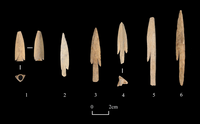| Geographical range | Xinjiang |
|---|---|
| Dates | 400–190 BCE |
| Type site | Shirenzigou 43°31′42″N 93°14′31″E / 43.528234°N 93.241880°E |
| Followed by | Xiongnu |
The Shirenzigou culture (Chinese: 石人子沟文化, ca. 410–190 BCE), also referred to as Dongheigou (东黑沟),[1] or Heigouliang-Dongheigou (黑沟梁-东黑沟),[2] is an archaeological culture from the Shirenzigou site in Barkol County, to the east of the Tarim Basin.
Skeletal evidence from sites in Shirenzigou and Xigou in eastern Xinjiang indicate that by the fourth century BCE both horseback riding and mounted archery were practiced along China's northwest frontier.[3]
Genetic studies on Iron Age individuals of the Shirenzigou site dated to circa 200 BCE have shown a fairly balanced admixture between the West Eurasian and East Eurasian genetic pools.[4] The West Eurasian component was Yamnaya-related, while the East Eurasian component was Northeast Asian-related. The Yamnaya component suggests a strong probability that the Shirenzigou populations were derived from the Afanasievo culture to the north, and spoke an Indo-European language.[4] This reinforces an Afanasievo origin hypothesis for the Tocharians, often called the "Steppe hypotheses", rather than an hypothese favouring BMAC and Andronovo culture origins, the "Bactrian Oasis hypotheses".[4]
Culturally, the Shirenzigou site showed strong affinity with the neighbouring Yanbulake culture close to the east and the Pazyryk culture to the northwest (deer-shaped griffin motifs) from the Altai region.[4] The Shirenzigou culture is sometimes considered as the easternmost expansion of the Pazyryk culture.[5] Beads were also imported from China.[4]
Looking at the archaeological and genetic evidence, the region has been suggested as an area of origin for the Yuezhi: the Yuegongtai-Xiheigou (岳公台-西黑沟) archaeological sites, corresponding to the Barkol culture in the Barkol County of Xinjiang. This would have positionned the Yuezhi between the Subeshi culture to their west, the Yanbulaq culture to their east, the aftermaths of the Chemurchek culture to the north, and a wide desertical area to south about a thousand kilometers away from the Central Plains of China.[6]
-
Shirenzigou map
-
Shirenzigou site with dwellings (yellow circles) and tombs (purple triangles)
-
Surroundings of the Shirenzigou archaeological site in Barkol County
-
Shirenzigou bone arrowheads
-
Shirenzigou dwelling F2 (from the North)
-
Shirenzigou dwelling F2, with artifacts
-
Principal component analysis (PCA) based on mitochondrial DNA (mtDNA) haplogroup frequencies of ancient and present-day Eurasian populations, with Shirenzigou samples
- ^ Wang, Yuxuan; Monteith, Francesca; Xi, Tongyuan; Ren, Meng; Li, Daren; Hu, Songmei; Wang, Jianxin; Festa, Marcella; Ma, Jian (16 March 2023). "New evidence for regional pastoral practice and social complexity in the Eastern Tianshan Mountains in the first millennium BCE". Scientific Reports. 13 (1): 4338. Bibcode:2023NatSR..13.4338W. doi:10.1038/s41598-023-31489-9. ISSN 2045-2322. PMC 10020425. PMID 36927890.
The Shirenzigou site (also referred to as Dongheigou) is located in the northern foothills of the Tianshan Mountains, in present day Balikun County.
- ^ Lan-Hai Wei, Ryan; Li, Hui; Xu, Wenkan (26–28 June 2013). "The separate origins of the Tocharians and the Yuezhi: Results from recent advances in archaeology and genetics". Conference: International Conference on Tocharian Manuscripts and Silk Road Culture at: University of Vienna, Vienna: 284.
The Heigouliang-Dongheigou sites are characterized by mound stone graves, dating to 200±70 B.C. With the application of cultural factor analysis, these sites were identified as the remains of ancient Xiongnu populations (Wang 2008, Mo 2010, Ren 2011).
- ^ Li, Yue; Zhang, Chengrui; Taylor, William Timothy Treal; Chen, Liang; Flad, Rowan K.; et al. (24 November 2020). "Early evidence for mounted horseback riding in northwest China". Proceedings of the National Academy of Sciences. 117 (47): 29569–29576. Bibcode:2020PNAS..11729569L. doi:10.1073/pnas.2004360117. ISSN 0027-8424. PMC 7703595. PMID 33139545.
- ^ a b c d e Ning, Chao; Wang, Chuan-Chao; Gao, Shizhu; Yang, Yang; Zhang, Xue; Wu, Xiyan; Zhang, Fan; Nie, Zhongzhi; Tang, Yunpeng; Robbeets, Martine; Ma, Jian; Krause, Johannes; Cui, Yinqiu (5 August 2019). "Ancient Genomes Reveal Yamnaya-Related Ancestry and a Potential Source of Indo-European Speakers in Iron Age Tianshan". Current Biology. 29 (15): 2526–2532.e4. Bibcode:2019CBio...29E2526N. doi:10.1016/j.cub.2019.06.044. ISSN 0960-9822. PMID 31353181.
Our results suggest that the Yamnaya and/or Afanasievo-related ancestry expanded further south through the Dzungarian Basin into the northern slope of the Tianshan Mountains in Xinjiang since at least the second millennium BCE and thus support the "Steppe hypothesis" for the early peopling of Xinjiang.
- ^ Rubinson, Karen S.; Linduff, Katheryn M. (February 2023). "Deer or Horses with Antlers? Wooden Figures Adorning Herders in the Altai". Arts. 12 (1): Figure 1. Map of Pazyryk Culture Sites. doi:10.3390/arts12010029. ISSN 2076-0752.
- ^ Lan-Hai Wei, Ryan; Li, Hui (2013). "The separate origins of the Tocharians and the Yuezhi: Results from recent advances in archaeology and genetics". International Conference on Tocharian Manuscripts and Silk Road CultureAt: University of Vienna, Vienna. 26–28 June 2013.







